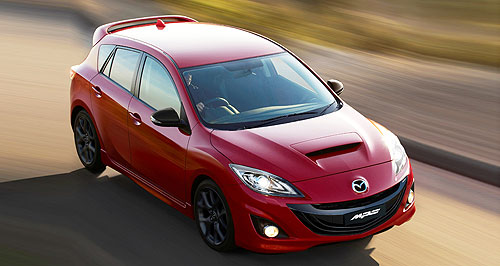Future models - Mazda - Mazda3 - MPSMazda moots MPS diesel drivetrainBooster: Mazda has suggested a diesel engine may be the drivetrain of choice for a future version of its traditionally turbo-petrol MPS (outgoing current mode pictured). A diesel engine could sit under the bonnet of the next firebrand Mazda3 MPS29 Nov 2013 By BARRY PARK in TOKYO MAZDA says it is considering a diesel drivetrain for a future version of its Volkswagen Golf GTI-fighting MPS – a vehicle that the car-maker says is still years away from production. The car-maker has revealed that the MPS – and a compact soft-roader that is likely to slip in under the CX-5 mid-size SUV – has a low priority as it concentrates on the global launch of bread-and-butter models including the Mazda3 small car and Mazda2 city runabout. Mazda global managing executive officer, Kiyoshi Fujiwara, said the car-maker was still tossing up between either a petrol or diesel drivetrain for the MPS – or even both. “Either is a possibility,” he said from the floor of the Tokyo motor show where a compressed natural gas version of the Mazda3 – a demonstration of the high-compression petrol engine’s ability to work with alternative fuels – was on show for the first time. Mr Fujiwara said the 2.2-litre Skyactiv-D engine was a candidate for the firebrand MPS because of the torque-laden performance characteristics the oil-burning drivetrain. The lack of development of a turbocharged petrol engine – Mr Fujiwara said a forced induction version of the SkyActiv powertrain was not yet in the works – also suggests the diesel drivetrain could be the only choice to slip under the bonnet of the MPS, although the car-maker says the diesel is no certainty. The idea of placing a modern-day diesel engine under the bonnet of a car and labelling it a performance variant has precedent. The Volkswagen Golf and Skoda’s Octavia have both had diesel-engined performance models, while the likes of luxury car-makers Audi and triple-turbo specialist BMW both have six-cylinder diesel-driven performance SUVs. Mr Fujiwara’s stance on the MPS backs that of Mazda global chief executive Masamichi Kogai, who also said the car-maker’s compact halo model was not necessarily in line for a petrol-fuelled powerplant. Mr Kogai said he believed diesel engines had much potential “in the future”. He said the diesel engine’s attributes were likely to counteract any performance-sapping weight gains made by substituting the petrol engine for a heavier diesel unit. “So if you put turbochargers and the likes on the gasoline engine, and compare it with the diesel, I think maybe the diesel engine will win,” Mr Kogai said. “Also I want to point out that because of the lower compression ratio (the Skyactiv-D uses an industry-low 14:1 compression ratio compared with about 16:1 for a conventional diesel engine) the cylinder head is aluminium, also contributing to lighter weight.” According to Mazda, the aluminium head alone has helped to save about 25kg in weight compared with the older cast-iron diesel engine. Mazda plans on bringing out five new models globally over the next five years as it works towards returning the company to strong profitability as it rolls towards its first positive annual result in three years. According to an industry insider, Mazda’s current focus is well and truly switched onto products that will help the bottom line, and not those that will fall into a niche as a halo model. In addition to the Mazda3 due on sale in Australia early next year – it is already on sale in Japan – the new product rollout is expected to start with the Kodo design-influenced Mazda2 due later next year. The seven-seat CX-9 is also due next year, and is expected to feature a turbocharged 2.0-litre petrol engine – an ideal candidate for an MPS model. Later models include the next-generation MX-5 two-seat sportscar in development with Fiat and due in about 2015, and a compact city car that is little more than a rumour at this stage. Mr Kogai said a CX-3 style compact SUV was not a part of the car-maker’s current development cycle, suggesting it could be at least 2014 before the Japanese brand has a contender in what is currently one of Australia’s fastest-growing new-car segments.  Read more25th of November 2013  Driven: Mazda’s hybrid futurePetrol-electric Mazda3 is an impressive first effort for the brand, but Oz off radar19th of November 2013  Tokyo show: Mazda flags fuel-choice futureFuel savings and choices form Mazda’s Tokyo line-upAll motor show Alfa Romeo Alfa Romeo Abarth Abarth Audi Audi Aston Martin Aston Martin BMW BMW Bentley Bentley Chrysler Chrysler Chevrolet Chevrolet Dodge Dodge Citroen Citroen Ferrari Ferrari DS DS Ford Ford Fiat Fiat FPV FPV Foton Foton Haval Haval Great Wall Great Wall Honda Honda Holden Holden Hyundai Hyundai HSV HSV Isuzu Isuzu Infiniti Infiniti Jeep Jeep Jaguar Jaguar Lamborghini Lamborghini Kia Kia Lexus Lexus Land Rover Land Rover Mazda Mazda Maserati Maserati Mercedes-Benz Mercedes-Benz McLaren McLaren Mini Mini Nissan Nissan Mitsubishi Mitsubishi Peugeot Peugeot Opel Opel Proton Proton Porsche Porsche Renault Renault Ram Ram Saab Saab Rolls-Royce Rolls-Royce Smart Smart Skoda Skoda Subaru Subaru SsangYong SsangYong Tesla Tesla Suzuki Suzuki Toyota Toyota Volvo VolvoMotor industry news |
Click to shareAll motor show Alfa Romeo Alfa Romeo Abarth Abarth Audi Audi Aston Martin Aston Martin BMW BMW Bentley Bentley Chrysler Chrysler Chevrolet Chevrolet Dodge Dodge Citroen Citroen Ferrari Ferrari DS DS Ford Ford Fiat Fiat FPV FPV Foton Foton Haval Haval Great Wall Great Wall Honda Honda Holden Holden Hyundai Hyundai HSV HSV Isuzu Isuzu Infiniti Infiniti Jeep Jeep Jaguar Jaguar Lamborghini Lamborghini Kia Kia Lexus Lexus Land Rover Land Rover Mazda Mazda Maserati Maserati Mercedes-Benz Mercedes-Benz McLaren McLaren Mini Mini Nissan Nissan Mitsubishi Mitsubishi Peugeot Peugeot Opel Opel Proton Proton Porsche Porsche Renault Renault Ram Ram Saab Saab Rolls-Royce Rolls-Royce Smart Smart Skoda Skoda Subaru Subaru SsangYong SsangYong Tesla Tesla Suzuki Suzuki Toyota Toyota Volvo VolvoMotor industry news |
















Facebook Twitter Instagram